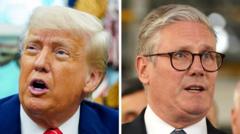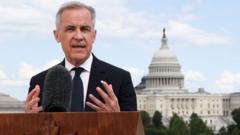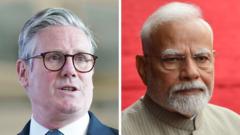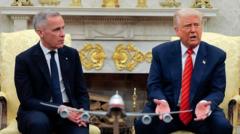**Shoppers appear hesitant despite government efforts, reflecting deeper economic challenges.**
**China's Economic Resilience Tested Amid Trade War with U.S.**

**China's Economic Resilience Tested Amid Trade War with U.S.**
**Amid rising tariffs, Beijing urges domestic spending as a means to counteract trade impacts.**
As the trade war intensifies between the United States and China, with President Trump maintaining high tariffs of over 125% on Chinese goods, the Chinese government is emphasizing the need for domestic consumption to mitigate the economic fallout. One bustling shopping district in Beijing offers a glimpse of the scene authorities hope to promote; however, the reality of consumer sentiment tells a different story.
In response to the ongoing economic strain, which includes retaliatory tariffs from China of 84% on all U.S. imports, government officials have called for a shift in focus towards boosting internal consumption. In a recent article in People's Daily, the Chinese Communist Party called for consumption to become a key driver of economic growth, highlighting the advantages of China’s large market.
However, driving consumer spending is proving to be a significant challenge. Even before the implementation of current tariffs, domestic consumption in China was sluggish. Post-pandemic recovery has been tepid, with factories closing, youth unemployment rates soaring, and home prices—critical for many middle-class families—taking a nosedive.
At a shopping venue like Taikoo Li in Beijing, while the streets are alive with activity, the reality is that many shoppers are less inclined to buy and more interested in window shopping or searching for discounts. Qu Nan, a 38-year-old businessman, reflects this mindset, as he spent time in a café without making a purchase.
The dichotomy between a vibrant urban environment and a cautious consumer base underscores the complexities facing China's economy as it grapples with external pressures and internal limitations. The government's ambitious push for buoying domestic consumption may take more than consumer enthusiasm to realize, as the specter of ongoing trade tensions looms large.
In response to the ongoing economic strain, which includes retaliatory tariffs from China of 84% on all U.S. imports, government officials have called for a shift in focus towards boosting internal consumption. In a recent article in People's Daily, the Chinese Communist Party called for consumption to become a key driver of economic growth, highlighting the advantages of China’s large market.
However, driving consumer spending is proving to be a significant challenge. Even before the implementation of current tariffs, domestic consumption in China was sluggish. Post-pandemic recovery has been tepid, with factories closing, youth unemployment rates soaring, and home prices—critical for many middle-class families—taking a nosedive.
At a shopping venue like Taikoo Li in Beijing, while the streets are alive with activity, the reality is that many shoppers are less inclined to buy and more interested in window shopping or searching for discounts. Qu Nan, a 38-year-old businessman, reflects this mindset, as he spent time in a café without making a purchase.
The dichotomy between a vibrant urban environment and a cautious consumer base underscores the complexities facing China's economy as it grapples with external pressures and internal limitations. The government's ambitious push for buoying domestic consumption may take more than consumer enthusiasm to realize, as the specter of ongoing trade tensions looms large.






















